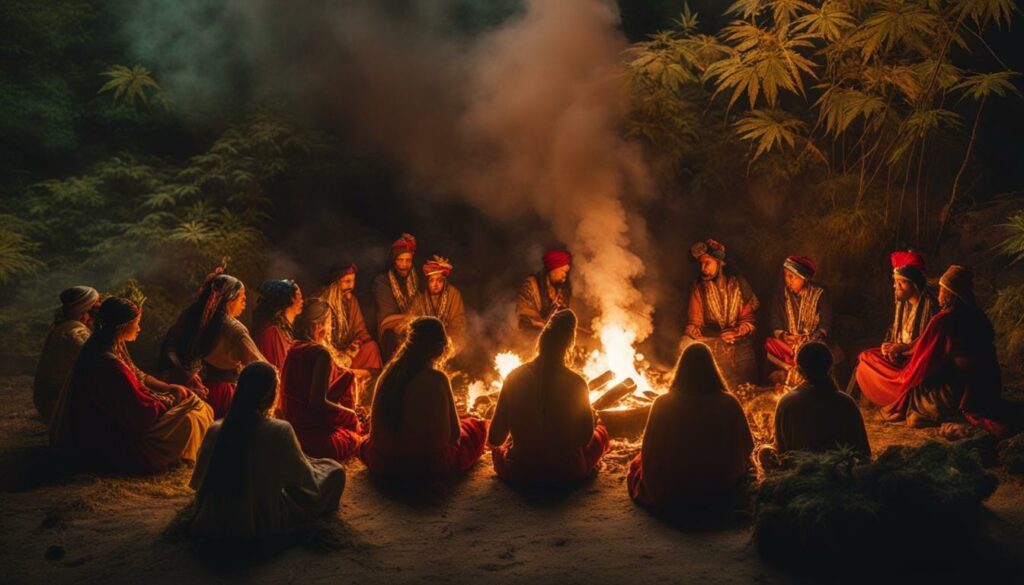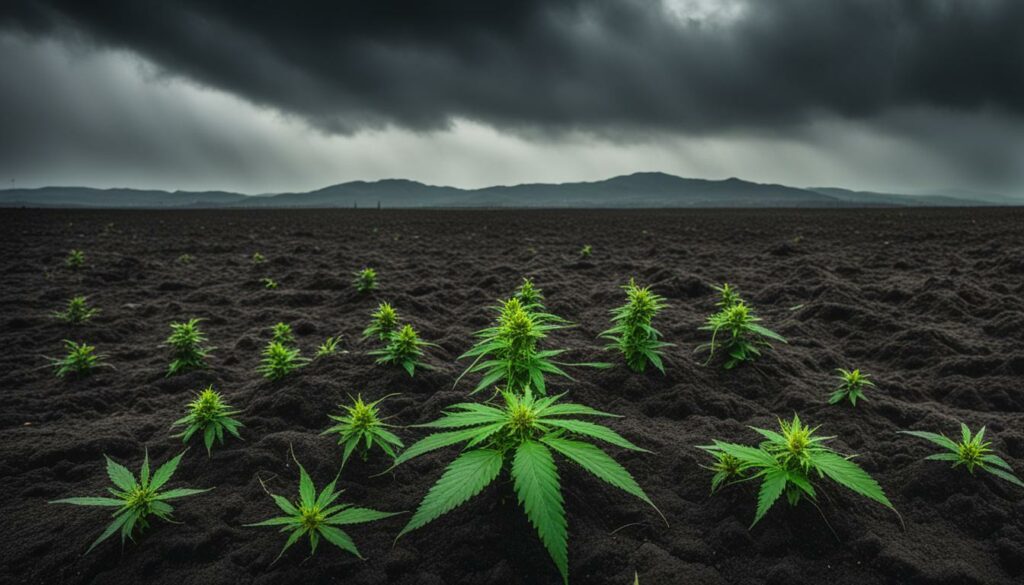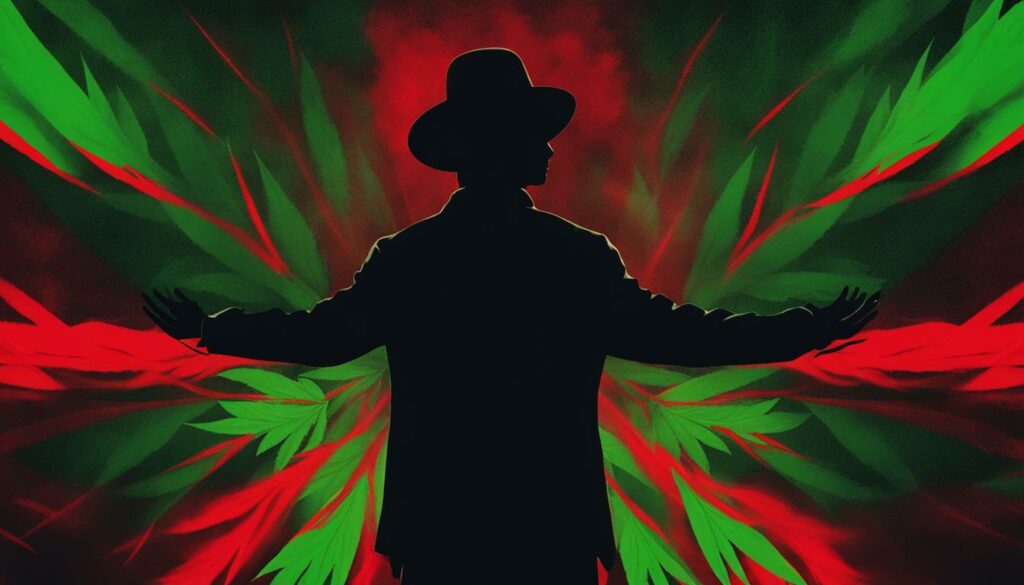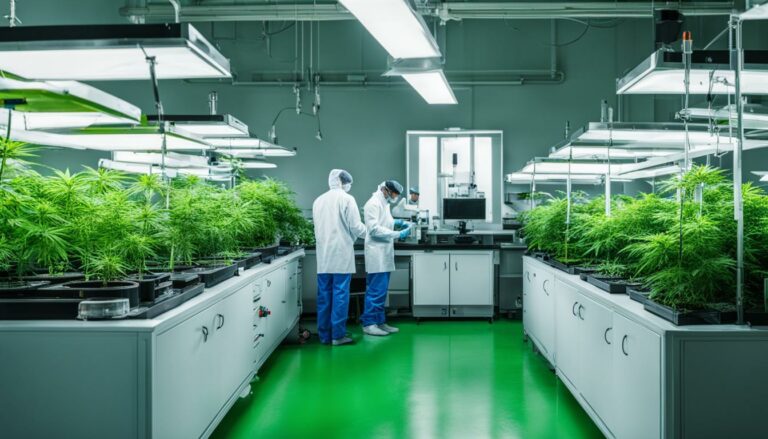From Ancient Rituals to Modern Medicine: The Fascinating Journey of Cannabis Through History
Cannabis has been a part of human history for thousands of years, with its use and cultural significance evolving over time. From its origins in ancient rituals to its present role in modern medicine, the journey of cannabis through history is nothing short of fascinating.
Ancient civilizations across the world revered cannabis for its therapeutic properties and used it in various religious and spiritual practices. From the Egyptians to the Chinese, cannabis played an important role in traditional medicine and was believed to cure a wide range of ailments.
However, in the 20th century, cannabis underwent a period of prohibition due to political and social factors. But in recent years, there has been a growing movement towards the legalization of cannabis, both for medical and recreational use.
Today, cannabis is a prominent player in the world of modern medicine, with promising research backing up its potential as a treatment for various conditions. As attitudes towards cannabis continue to change and the legal landscape shifts, the future of this fascinating plant is full of possibilities.
Key Takeaways:
- Cannabis has been used for thousands of years in various cultures for different purposes, including religious and medicinal practices.
- The prohibition of cannabis in the 20th century led to its criminalization, but the recent trend towards legalization has opened up new possibilities for its use.
- Cannabis is increasingly being recognized for its therapeutic potential and is being researched for its potential to treat various medical conditions.
- The future of cannabis is full of possibilities, with advancements in research, technology, and regulations paving the way for new cannabis-based treatments and changing market trends.
- Understanding the history and cultural significance of cannabis is crucial to appreciating its role in modern society and its potential for the future.
Ancient Uses of Cannabis
For thousands of years, cannabis has been used for a wide range of purposes. From its early cultivation for its fibres and seeds to its use in religious and spiritual rituals, the plant has played a significant role in different cultures across the world. This section will delve into the ancient uses of cannabis and its cultural significance.
Cultural Significance of Cannabis
Cannabis has been an integral part of many cultures for centuries, with evidence of its use dating back to ancient civilizations in China, India, and the Middle East. Its use in spiritual and religious rituals is well-documented, with some cultures believing that the plant has divine properties.
In Hinduism, cannabis is associated with the god Shiva and is believed to represent his powers of destruction and creation. Similarly, in ancient Mesopotamia, cannabis was used in religious ceremonies to communicate with the gods.
Aside from its spiritual significance, cannabis was also valued for its medicinal properties. In ancient China, it was used to treat a variety of ailments, including pain, nausea, and digestive issues.
Cannabis in Ancient Agriculture
Cannabis has been cultivated for thousands of years for its fibres, which were used for making textiles and rope. The ancient Chinese used cannabis to make paper, and the plant was also used in the production of sails and clothing in Europe and the Middle East.
Ancient Chinese texts also document the use of cannabis seeds as a food source. The seeds were believed to have nourishing properties and were used in cooking and baking.
Medical Uses of Cannabis in Ancient Times
Cannabis was widely used in traditional medicine across different cultures throughout history. In ancient Egypt, it was used for treating inflammation and as a painkiller.
Ancient Greek physician Dioscorides included cannabis in his list of medicinal plants, describing its use for treating earaches, edema, and dental pain.
In traditional Indian medicine, cannabis was used to treat a wide range of ailments, including headaches, fever, and epilepsy.
The Role of Cannabis in Shamanic Rituals
Cannabis played a vital role in many shamanic rituals throughout history. In Siberia, shamans used cannabis to communicate with spirits and to induce visions. They believed that cannabis had the power to reveal hidden truths and unlock spiritual insight.
Similarly, Native American tribes used cannabis in spiritual ceremonies, believing that the plant had the ability to connect them with the divine.
Cannabis as a Recreational Drug
While cannabis was mostly used for medicinal and spiritual purposes in ancient times, there is evidence that it was also used recreationally in some cultures. In ancient Greece, cannabis was used in social settings and was believed to enhance the enjoyment of music and food.
Similarly, in Jamaica, cannabis was used for recreational purposes in social gatherings known as “reasoning sessions”. These sessions were believed to foster community and to promote philosophical and spiritual discussions among participants.
As we can see, cannabis has had a diverse and fascinating history, playing a crucial role in various cultural practices and spiritual rituals. Its therapeutic properties and cultural significance have been recognized throughout history, and its uses have evolved over time to meet the changing needs of society.
Cannabis in Traditional Medicine
The use of cannabis in traditional medicine dates back centuries, with ancient cultures recognizing its therapeutic potential. From China to India to the Middle East, cannabis has been used to treat a variety of ailments, including pain, inflammation, and digestive issues.
Chinese Medicine
In Chinese medicine, cannabis was commonly used for its analgesic properties, particularly in cases of rheumatism and menstrual pain. The plant was also used to treat constipation, malaria, and as a sedative.

Ayurvedic Medicine
In Ayurvedic medicine, cannabis was known as “ganja” and was used to treat a range of conditions, such as anxiety, insomnia, and pain. It was also used as an appetite stimulant and to relieve nausea.
Middle Eastern Medicine
In Middle Eastern medicine, cannabis was used to treat inflammation, pain, and as an antiseptic. It was also used as an anesthetic during surgical procedures.
“The medical use of cannabis is not a new concept; it has been used for thousands of years as a natural remedy for a variety of ailments. Only in recent times has it been subject to controversy and legal restrictions.”
“[Cannabis] is one of the most versatile medicines we have. Its potential therapeutic applications are diverse, ranging from pain relief to epilepsy treatment. The challenge lies in unlocking its full potential while mitigating any potential risks.”
As modern medicine continues to explore the therapeutic potential of cannabis, it is important to recognize the historical significance of its use in traditional medicine. By studying the practices of ancient cultures, we can gain valuable insights into the potential benefits and risks of using cannabis in modern medicine.
Prohibition and Legalization of Cannabis
The history of cannabis is marked by a complex relationship between the plant and the law. While it was widely used for medicinal and spiritual purposes in ancient times, cannabis has been the subject of much legal debate in more recent years. In this section, we will explore the prohibition and legalization of cannabis, examining the social and political factors that have shaped its legal status over time.
Prohibition of cannabis has its roots in the early 20th century, when many countries began to restrict its use due to concerns over its psychoactive effects and potential for addiction. In the United States, the 1937 Marihuana Tax Act effectively criminalized the possession and sale of cannabis, paving the way for a broader prohibition throughout much of the world.
The movement to reverse this prohibition gained momentum in the late 20th century, with calls for the legalization of cannabis for medical and recreational use. In 1996, California became the first US state to legalize medical cannabis, and since then, numerous other states and countries have followed suit.
Despite the growing acceptance of cannabis, legalization remains a controversial issue, with opponents citing concerns over the potential health risks of cannabis use and its potential impact on society. Nevertheless, the trend towards legalization appears to be gaining momentum, with many countries now moving towards decriminalization and even full legalization of cannabis.
Evolution of Cannabis Cultivation
Cannabis cultivation has come a long way since its ancient origins. As the demand for cannabis grew, so did the need for more efficient and effective cultivation methods. Over time, growers have experimented with different techniques to enhance the plant’s potency, flavour, and overall quality. Today, cannabis cultivation has become a science, with sophisticated methods and technologies allowing for precise control over the growing environment.
Traditional Cultivation Techniques
Traditional cultivation techniques involved planting cannabis seeds outdoors, in soil, and relying on natural sunlight for growth. These methods could result in unpredictable yields and inconsistent quality, as external factors such as weather conditions and pests could easily affect the crop. In response, growers developed various techniques to protect the plant from external factors, such as intercropping with other plants to act as natural pesticides and using companion planting to enhance soil fertility.
Hybridization and Breeding
As the industry grew, hybridization and breeding became popular methods for creating new cannabis strains with desired characteristics. Growers experimented with crossbreeding different strains to produce offspring with improved potency, flavour, and yield. This led to the development of numerous hybrid strains that combine the strengths of different parent strains, resulting in a vast variety of cannabis options for consumers.
Indoor Cultivation
Indoor cultivation allows for complete control over the growing environment, ensuring consistent quality and higher yields. Growers can regulate factors such as temperature, humidity, lighting, and nutrient levels to create customized growing conditions for each strain. This method also allows for year-round cultivation and the ability to grow cannabis in regions where outdoor cultivation may be challenging due to climate or legal restrictions.
Advanced Technologies
Advancements in technology have enabled even more precise control over the growing environment. Techniques such as hydroponics and aeroponics allow for the plant’s roots to be suspended in nutrient-rich water or misted with nutrient solution, providing an optimal growing environment with faster growth rates and higher yields. Additionally, lighting technology has developed to provide customized lighting spectrums that can enhance specific stages of plant growth.
| Traditional Cultivation | Indoor Cultivation | Advanced Technologies |
|---|---|---|
| Relied on natural sunlight | Controlled environment for consistent quality and yields | Hydroponics and aeroponics for optimal growth |
| Unpredictable yields and quality | Year-round cultivation and ability to grow in challenging regions | Customized lighting spectrums for enhanced growth |
| Subject to external factors such as weather and pests | Precise control over factors such as temperature, humidity, and light | Faster growth rates and higher yields |
Cannabis cultivation has evolved significantly over time, from ancient outdoor cultivation to modern indoor cultivation and advanced technologies. The future of cannabis cultivation is exciting, with the potential for even more precise and efficient cultivation techniques. As the industry continues to grow, we can expect to see further advancements in breeding, genetics, and technology, leading to even more diverse cannabis strains with unique characteristics and benefits.
Historical Cannabis Strains
The use of cannabis has been prevalent throughout history, with various strains cultivated for different purposes. Here are some of the most noteworthy historical cannabis strains:
| Strain | Origin | Cultural Significance |
|---|---|---|
| Charas | India | A type of hand-pressed hashish that has been used for centuries in religious ceremonies and social gatherings. |
| Thai Stick | Thailand | A potent strain that was popularized in the 1970s and gained a reputation for its high quality and unique aroma. It was also associated with the “hippie” counterculture movement. |
| Afghan Kush | Afghanistan | A pure indica strain that has been used for medicinal purposes for centuries. It is known for its relaxing and therapeutic effects, making it popular among patients seeking pain relief and stress reduction. |
| Haze | California, USA | A hybrid strain that originated in the 1960s and 70s, characterized by its uplifting and energizing effects. It played a significant role in shaping the modern cannabis industry and remains popular among recreational users. |
These strains have left a lasting impact on the cannabis industry and culture, with many still popular today. As cannabis legalization continues to spread around the world, it will be interesting to see how these historical strains evolve and adapt in the modern era.
Cannabis in Cultural Practices
Cannabis has been an integral part of cultural practices in various societies throughout history. From religious ceremonies to artistic expressions, it has been used in diverse ways to create a sense of community and connection.
One notable example is its use in Rastafarianism, a spiritual movement that originated in Jamaica in the 1930s. Rastafarians believe that cannabis, which they call “ganja”, is a sacrament that facilitates spiritual growth and consciousness. They use it in their worship services and ceremonies, incorporating it into their music and art.
Cannabis has also played a significant role in ancient Indian culture, where it is known as “bhang”. It has been used in religious festivals such as Holi, where it is consumed in drinks and sweets. Bhang has been described as a “gift from the gods” and is believed to have medicinal properties.

In modern times, cannabis has been embraced by the artistic community, with many musicians, writers, and visual artists incorporating it into their work. It has been associated with creativity and free-thinking, inspiring artists to push boundaries and challenge the status quo.
“I had a revelation during my high school years – that I was a brilliant artist. I felt that I was the Van Gogh of the ghetto.” – Tupac Shakur
Cannabis has also been used in social gatherings, providing a way for friends and colleagues to bond and relax. Its use has been normalized in some cultures, with “coffee shops” in the Netherlands offering a social and legal space for cannabis consumption.
Despite its cultural significance, the use of cannabis remains a contentious issue in many societies. However, its role in cultural practices cannot be ignored and highlights the deep connections between cannabis and human culture.
Cannabis in Modern Medicine
With the growing acceptance and legalization of cannabis, more research has been conducted into its potential therapeutic applications, and the results have been promising. Cannabis has been found to contain compounds such as THC and CBD that have various therapeutic effects on the human body.
One of the most significant uses of cannabis in modern medicine is in pain management. Chronic pain affects millions of people worldwide, and traditional painkillers can cause severe side effects and even addiction. However, cannabis-based treatments have been found to be effective in treating pain, with fewer side effects and a lower risk of addiction.
Cannabis has also been found to be beneficial in treating epilepsy, with some studies showing that it can reduce the frequency and severity of seizures. It has also been found to alleviate symptoms of multiple sclerosis, with some patients reporting significant improvements in pain, spasticity, and muscle spasms.
Another area where cannabis shows potential is in treating mental health conditions such as anxiety and PTSD. CBD, a non-psychoactive compound found in cannabis, has been found to have anxiolytic properties and may be effective in reducing anxiety symptoms in some patients.
The use of cannabis in modern medicine is still a developing area, and more research is needed to fully understand its potential. However, the growing body of evidence supporting its use in various medical conditions has led to increased acceptance and legalization of cannabis for medical purposes.
The Endocannabinoid System
To understand how cannabis works in the body, it is essential to understand the endocannabinoid system (ECS). The ECS is a complex network of receptors and neurotransmitters that regulate various functions in the body, such as mood, appetite, pain, and inflammation.
When cannabis is consumed, the compounds in it, such as THC and CBD, interact with the ECS, activating the receptors and affecting the neurotransmitters’ activity. This interaction can lead to various therapeutic effects, such as pain relief, reduced inflammation, and improved mood regulation.
Cannabis-Based Medicines
The potential therapeutic applications of cannabis have led to the development of various cannabis-based medicines. These medicines are designed to deliver precise doses of cannabis compounds to patients, ensuring that they receive the therapeutic benefits without the psychoactive effects.
One of the most well-known cannabis-based medicines is Sativex, which is used to treat multiple sclerosis-related spasticity. Sativex contains a mix of THC and CBD and is administered as an oral spray.
Another cannabis-based medicine is Epidiolex, which is used to treat severe forms of epilepsy. Epidiolex contains CBD and is administered as an oral solution.
Cannabis and Cancer
Another area where cannabis shows potential is in cancer treatment. Cannabis has been found to have anti-tumor properties, and some studies have suggested that it may be effective in slowing the growth of certain types of cancer cells.
Cannabis has also been found to be effective in treating the side effects of cancer treatment, such as nausea and vomiting. Some cancer patients have reported that cannabis has been more effective in managing these side effects than traditional medications.
The Current Landscape of Cannabis Legalisation
As of August 2021, 50 countries have legalised cannabis-based medicines, while 18 countries have legalised cannabis for recreational use. The legalisation of cannabis for both medical and recreational purposes has been gaining momentum in recent years, with more and more countries changing their laws.
Canada was the first G7 country to legalise cannabis for recreational use in 2018, while Uruguay was the first country in the world to legalise cannabis for both medical and recreational use back in 2013. In the United States, cannabis is legal for recreational use in 19 states and Washington D.C., while medical cannabis is legal in 36 states.
However, despite the growing trend towards legalisation, many countries still have strict laws prohibiting cannabis use. In some countries, possession of cannabis can result in severe punishment, including imprisonment and even the death penalty.
The Regulatory frameworks in place
The regulatory frameworks for cannabis legalisation vary greatly between different countries and states. In some places, cannabis is sold in government-run stores, while in others, it is sold by private companies. Some countries have strict regulations in place to ensure the safety and quality of cannabis products, while others have more relaxed regulations.
For example, in Canada, cannabis is tightly regulated, with strict packaging and labelling requirements, as well as strict quality control measures. In contrast, in some US states, cannabis regulation is more relaxed, with less stringent packaging and labelling requirements.
The Economic Impact of Legalisation
Legalising cannabis has a significant economic impact on the countries that have implemented it. For example, in Canada, the cannabis industry was worth $2.6 billion in 2020, and it is estimated that it could reach $10 billion by 2025.
In the United States, the legal cannabis industry is projected to reach $70.6 billion by 2029, with job creation expected to reach over 400,000 by 2028. Legalisation also generates tax revenue for governments, which can be used to fund public services such as healthcare and education.
The ongoing Debate
The debate around cannabis legalisation is ongoing, with proponents arguing that it has therapeutic benefits and that criminalising cannabis use has led to disproportionate penalties for communities of colour.
Opponents argue that cannabis use has negative health effects and that legalisation could lead to increased use and harm. There are also concerns about the potential impact on public safety and the risk of impaired driving.
Despite the ongoing debate, the trend towards legalisation is likely to continue, with more and more countries recognising the potential benefits of legalising cannabis for both medical and recreational use.

Public Perception and Debates
As the movement for the prohibition and legalization of cannabis continues to gain momentum, debates around the social, economic, and health implications of cannabis use persist. While some advocate for the complete legalization of cannabis, others are more cautious, emphasizing the potential risks associated with its use.
One of the main debates surrounding cannabis prohibition and legalization is its impact on public health. While some studies suggest that cannabis use may have therapeutic properties, there are also concerns that it may have negative health effects, particularly on young people. As such, many countries have introduced regulations to restrict access to cannabis and limit its use, particularly among minors.

Another key issue in the ongoing debates around cannabis prohibition and legalization is its impact on crime rates. Prohibitionists argue that cannabis use is closely linked to crime and that legalizing it could lead to an increase in criminal activity. However, supporters of legalization argue that it could actually reduce crime rates, by eliminating the black market trade in cannabis and providing a regulated, legal source of the drug.
The economic impact of cannabis legalization is also a contentious issue. While some believe that the cannabis industry has the potential to create jobs and boost economic growth, others are less optimistic, pointing to the potential for increased healthcare costs, lost productivity, and other negative economic impacts.
Overall, the debates around cannabis prohibition and legalization are complex and multifaceted, reflecting the diverse views and concerns of various stakeholders. As the world continues to grapple with the issue, it is clear that there are no easy answers or quick fixes. However, by engaging in thoughtful, informed discussions and considering all sides of the issue, we can work towards finding a solution that balances the potential benefits and risks of cannabis use.
Cannabis Industry and Economic Impact
The growing acceptance and legalization of cannabis has led to the emergence of a thriving industry with a significant economic impact. According to a report by New Frontier Data, the legal cannabis market in the United States alone was worth $13.6 billion in 2019, with an expected growth to $30 billion by 2025.
The cannabis industry has created numerous job opportunities, from cultivators and manufacturers to distributors and retailers. In the US, it is estimated that the cannabis industry employs over 240,000 people, with some states seeing a significant job growth rate. For example, in Oregon, cannabis job growth was at 171% in 2017, outpacing the job growth rate in any other industry.

In addition to job creation, the cannabis industry also generates significant tax revenues for the government. In states where cannabis has been legalized, such as California and Colorado, taxes collected from cannabis sales have reached billions of dollars. The tax revenue from cannabis sales has been used to fund various initiatives, including education, public safety, and healthcare.
However, the economic impact of the cannabis industry is not limited to job creation and tax revenues. Legalization has also led to an increase in property values and new business development in areas where cannabis has been legalized. For example, in California, the legalization of cannabis has led to a surge in property prices in areas where cultivation and manufacturing facilities have been established.
The Green Rush: A New Era of Opportunity
“The cannabis industry represents a new era of opportunity, not just for entrepreneurs and investors but also for communities that have been historically marginalized by the failed war on drugs. It is a chance to create a more equitable and inclusive economy that benefits everyone.”
The legalization of cannabis has presented a unique opportunity for entrepreneurs and investors to enter a new and rapidly growing industry. However, as the industry continues to evolve, it is important to ensure that it remains ethical and inclusive, reflecting the values of the communities it serves.
- The cannabis industry has the potential to create opportunities for communities that have been disproportionately affected by the war on drugs, including people of colour and low-income communities. As the industry continues to grow, it is important to prioritize social equity and ensure that everyone has an equal chance to participate and benefit from its success.
- The cannabis industry also has a responsibility to operate sustainably, minimizing its impact on the environment and contributing to the health and well-being of communities. This includes developing eco-friendly cultivation methods and investing in social programs that support public health and education.
In conclusion, the cannabis industry represents a new era of opportunity and growth, with significant economic impact and potential for positive social change. As the industry continues to evolve, it is important to prioritize ethical and inclusive practices that benefit everyone, creating a sustainable future for the cannabis industry and the communities it serves.
The Future of Cannabis
The future of cannabis is a topic of hot debate, with many different possibilities and potential outcomes. With the growing acceptance and legalization of cannabis around the world, the next few decades are likely to see significant changes and advancements in the industry.
Advancements in Research and Technology
As research into the therapeutic properties of cannabis continues, we can expect to see exciting new discoveries and treatments emerge. From developing new strains with specific medical benefits to creating cannabis-based medications for a wide range of conditions, the potential for cannabis in modern medicine is vast.
In addition, technology is rapidly advancing, from innovative cultivation techniques to new consumption methods. With the development of vaporizers, edibles, and other delivery methods, cannabis is becoming more accessible and user-friendly than ever before.
Changing Regulatory Frameworks
The global trend towards cannabis legalization shows no signs of slowing down, with more and more countries and states legalizing cannabis for medical and recreational use. As regulatory frameworks adapt to these changes, we can expect to see more standardized testing and quality control measures, as well as increased market competition and innovation.
However, there are still many challenges to be overcome, including conflicting regulations between countries and the ongoing debate around drug policy and public health.
Economic Impacts and Job Creation
The growth of the cannabis industry has already had a significant economic impact, providing new job opportunities and generating tax revenues for governments. As the industry continues to expand, there is potential for even greater economic growth and job creation in regions where cannabis has been legalized.
However, this growth must be balanced with responsible business practices and ethical considerations, particularly in terms of social justice and equity in the cannabis industry.

Conclusion
As we conclude the journey through the fascinating history of cannabis, we are left with a profound appreciation for this plant’s multifaceted nature. From its ancient use in sacred rituals to its present-day role in modern medicine, cannabis has undergone an incredible evolution.
Despite its controversial past and ongoing debates, cannabis has emerged as a powerful force for positive change in society. As we continue to explore the therapeutic potential of cannabis, we are uncovering new ways to address some of the most pressing health challenges of our time.
As we look to the future, the possibilities for cannabis are truly endless. With advancements in research, technology, and regulations, we have the potential to unlock new frontiers in medicine, create new industries and generate economic growth, and forge a more harmonious relationship with nature.
The Rich and Diverse Cannabis History
Throughout its journey, cannabis has been a constant companion to humanity, offering us its healing properties, its cultural significance, and its endless potential. From its origins as a sacred plant in ancient rituals to its current status as a global phenomenon, cannabis history is rich and diverse.
We hope that this journey has provided you with a deeper understanding and appreciation for this remarkable plant. As we continue to explore the many facets of cannabis, we invite you to join us on this inspiring journey towards a brighter future.
The End of the Journey
This marks the end of our journey through the history of cannabis. We hope you enjoyed reading this article as much as we enjoyed creating it. If you have any questions or comments, please feel free to reach out to us. Thank you for joining us on this incredible journey through time and cannabis history.
FAQ
How long has cannabis been used by humans?
Cannabis has been used by humans for thousands of years, with evidence of its use dating back to ancient civilizations.
What were the ancient uses of cannabis?
Ancient civilizations used cannabis for various purposes, including religious rituals, spiritual practices, and cultural ceremonies.
How was cannabis used in traditional medicine?
Cannabis was used in traditional medicine to treat a wide range of ailments, including pain, inflammation, and digestive issues.
When did cannabis become illegal?
Cannabis became illegal in the 20th century due to social and political factors, leading to its prohibition in many countries.
How has cannabis cultivation evolved over time?
Cannabis cultivation techniques have evolved significantly, leading to the development of diverse cannabis strains with varying characteristics.
Are there any historical cannabis strains of note?
Yes, there are several historical cannabis strains that have played a significant role in shaping the cannabis industry and have cultural significance.
How has cannabis been integrated into different cultures?
Cannabis has been integrated into different cultures through religious ceremonies, social gatherings, and artistic expressions.
Is there scientific research supporting the medical use of cannabis?
Yes, scientific research has shown potential therapeutic applications of cannabis in pain management, epilepsy treatment, and symptom alleviation.
Which countries have legalized cannabis?
Several countries and states have legalized cannabis for medical and/or recreational use, each with its own regulatory framework in place.
What are the ongoing debates surrounding cannabis legalization?
The debates surrounding cannabis legalization revolve around its social, economic, and health implications, with varying perspectives and opinions.
What is the economic impact of the cannabis industry?
The emerging cannabis industry has significant economic impact, including job creation, tax revenues, and potential economic growth in legalized regions.
What does the future hold for cannabis?
The future of cannabis includes advancements in research, technology, and regulations, as well as potential challenges and opportunities for the industry.














